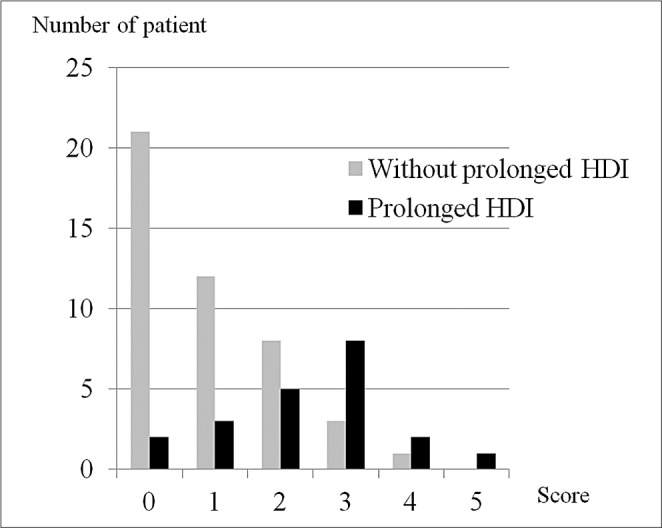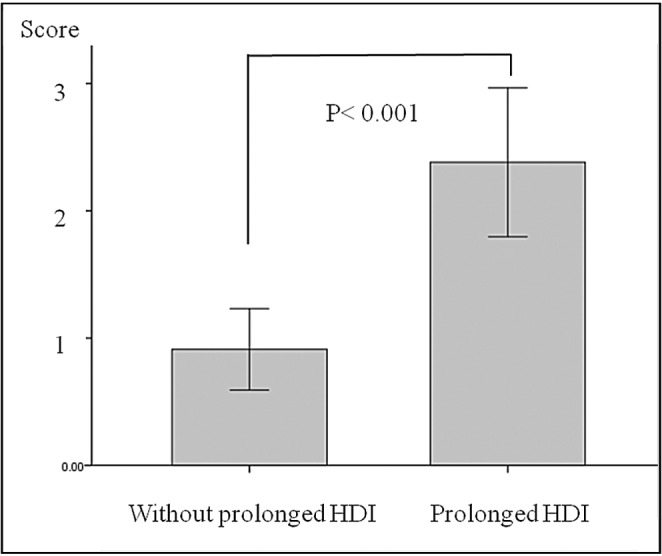Neurointervention.
2016 Sep;11(2):120-126. 10.5469/neuroint.2016.11.2.120.
Prediction of Prolonged Hemodynamic Instability During Carotid Angioplasty and Stenting
- Affiliations
-
- 1Department of Neurosurgery, Jeju National University College of Medicine, Jeju, Korea.
- 2Department of Neurosurgery, Hallym University College of Medicine, Chuncheon, Korea. jjs6553@daum.net
- 3Department of Neurology, Konkuk University College of Medicine, Seoul, Korea.
- 4Department of Radiology, Seoul National University College of Medicine, Seoul, Korea.
- 5Department of Neurosurgery, Bundang Jesaeng Hospital, Bundang, Korea.
- 6Department of Neurosurgery, Catholic University College of Medicine, Incheon, Korea.
- KMID: 2350690
- DOI: http://doi.org/10.5469/neuroint.2016.11.2.120
Abstract
- PURPOSE
The aim of this study was to assess the risk factors of prolonged hemodynamic instability (HDI) after carotid angioplasty and stenting (CAS). Herein, a simplified predictive scoring system for prolonged HDI is proposed.
MATERIALS AND METHODS
Sixty-six patients who had CAS from 2011 to 2016 at a single institution were evaluated. Prolonged HDI was defined as systolic blood pressure >160 mm Hg or <90 mm Hg or heart rate <50 beats/min, lasting over 30 minutes despite medical treatments. For the study, clinical data and radiologic data, including plaque morphology and stenosis were analyzed.
RESULTS
Prolonged HDI was observed in 21 patients (31.8%). Multivariable analysis revealed that calcification (OR, 6.726; p=0.006), eccentric stenosis (OR, 3.645; p=0.047) and extensive plaque distribution (OR, 7.169; p=0.006) were related to prolonged HDI. According to these results, a simplified scoring scale was proposed based on the summation of points: 2 points for calcified plaque, 2 points for extensive plaque distribution, and 1 point for eccentric stenosis. The percentages of prolonged HDI according to the total score were as follows: score 0, 8.7%; score 1, 20.0%; score 2, 38.5%; score 3, 72.7%; score 4, 66.7%; score 5, 100%. From the analysis, the total score in patients with prolonged HDI was significantly higher than those without prolonged HDI (p<0.001).
CONCLUSION
Prolonged HDI can be associated with calcification of plaque, eccentric stenosis and extensive plaque distribution, and a simplified scoring system enables prediction of prolonged HDI according to our cohort.
MeSH Terms
Figure
Cited by 1 articles
-
Protected versus Unprotected Carotid Artery Stenting : Meta-Analysis of the Current Literature
Young Dae Cho, Sung-Eun Kim, Jeong Wook Lim, Hyuk Jai Choi, Yong Jun Cho, Jin Pyeong Jeon
J Korean Neurosurg Soc. 2018;61(4):458-466. doi: 10.3340/jkns.2017.0202.001.
Reference
-
1. Dietz A, Berkefeld J, Theron JG, Schmitz-Rixen T, Zanella FE, Turowski B, et al. Endovascular treatment of symptomatic carotid stenosis using stent placement: long-term follow-up of patients with a balanced surgical risk/benefit ratio. Stroke. 2001; 32:1855–1859. PMID: 11486116.2. Brown MM, Venables G, Clifton A, Gaines P, Taylor RS. Carotid endarterectomy vs carotid angioplasty. Lancet. 1997; 349:880–881. PMID: 9121285.
Article3. Brooks WH, McClure RR, Jones MR, Coleman TL, Breathitt L. Carotid angioplasty and stenting versus carotid endarterectomy for treatment of asymptomatic carotid stenosis: a randomized trial in a community hospital. Neurosurgery. 2004; 54:318–324. PMID: 14744277.
Article4. Nonaka T, Oka S, Miyata K, Mikami T, Koyanagi I, Houkin K, et al. Prediction of prolonged postprocedural hypotension after carotid artery stenting. Neurosurgery. 2005; 57:472–477. PMID: 16145525.
Article5. Qureshi AI, Luft AR, Sharma M, Janardhan V, Lopes DK, Khan J, et al. Frequency and determinants of postprocedural hemodynamic instability after carotid angioplasty and stenting. Stroke. 1999; 30:2086–2093. PMID: 10512911.
Article6. Nandalur KR, Baskurt E, Hagspiel KD, Finch M, Phillips CD, Bollampally SR, et al. Carotid artery calcification on CT may independently predict stroke risk. AJR Am J Roentgenol. 2006; 186:547–552. PMID: 16423966.
Article7. Jeon JS, Sheen SH, Hwang G. Hemodynamic instability during carotid angioplasty and stenting-relationship of calcified plaque and its characteristics. Yonsei Med J. 2013; 54:295–300. PMID: 23364959.
Article8. North American Symptomatic Carotid Endarterectomy Trial Collaborators. Beneficial effect of carotid endarterectomy in symptomatic patients with high-grade carotid stenosis. N Engl J Med. 1991; 325:445–453. PMID: 1852179.9. Waller BF. The eccentric coronary atherosclerotic plaque: morphologic observations and clinical relevance. Clin Cardiol. 1989; 12:14–20. PMID: 2912603.
Article10. Cieri E, De Rango P, Maccaroni MR, Spaccatini A, Caso V, Cao P. Is haemodynamic depression during carotid stenting a predictor of peri-procedural complications? Eur J Vasc Endovasc Surg. 2008; 35:399–404. PMID: 18178113.
Article11. Im SH, Han MH, Kim SH, Kwon BJ. Transcutaneous temporary cardiac pacing in carotid stenting: noninvasive prevention of angioplasty-induced bradycardia and hypotension. J Endovasc Ther. 2008; 15:110–116. PMID: 18254669.12. Chalmers J, Pilowsky P. Brainstem and bulbospinal neurotransmitter systems in the control of blood pressure. J Hypertens. 1991; 9:675–694. PMID: 1680911.
Article13. Mangin L, Medigue C, Merle JC, Macquin-Mavier I, Duvaldestin P, Monti A, et al. Cardiac autonomic control during balloon carotid angioplasty and stenting. Can J Physiol Pharmacol. 2003; 81:944–951. PMID: 14608411.
Article14. Leisch F, Kerschner K, Hofman R, Bibl D, Engleder C, Bergmann H. Carotid stenting: acute results and complications. Z Kardiol. 1999; 88:661–668. PMID: 10525928.15. Morrish W, Grahovac S, Douen A, Cheung G, Hu W, Farb R, et al. Intracranial hemorrhage after stenting and angioplasty of extracranial carotid stenosis. AJNR Am J Neuroradiol. 2000; 21:1911–1916. PMID: 11110546.16. Mlekusch W, Schillinger M, Sabeti S, Nachtmann T, Lang W, Ahmadi R, et al. Hypotension and bradycardia after elective carotid stenting: frequency and risk factors. J Endovasc Ther. 2003; 10:851–859. PMID: 14658927.
Article17. Wong JH, Findlay JM, Suarez-Almazor ME. Hemodynamic instability after carotid endarterectomy: risk factors and associations with operative complications. Neurosurgery. 1997; 41:35–41. PMID: 9218293.
Article18. Schulz UG, Rothwell PM. Sex differences in carotid bifurcation anatomy and the distribution of atherosclerotic plaque. Stroke. 2001; 32:1525–1531. PMID: 11441196.
Article19. Cayne NS, Faries PL, Trocciola SM, Saltzberg SS, Dayal RD, Clair D, et al. Carotid angioplasty and stent-induced bradycardia and hypotension: impact of prophylactic atropine administration and prior carotid endarterectomy. J Vasc Surg. 2005; 41:956–961. PMID: 15944593.
Article20. Dangas G, Laird JR Jr, Satler LF, Mehran R, Mintz GS, Larrain G, et al. Postprocedural hypotension after carotid artery stent placement: predictors and short- and long-term clinical outcomes. Radiology. 2000; 215:677–683. PMID: 10831683.
Article21. Taha MM, Toma N, Sakaida H, Hori K, Maeda M, Asakura F, et al. Periprocedural hemodynamic instability with carotid angioplasty and stenting. Surg Neurol. 2008; 70:279–285. PMID: 18262636.
Article22. Fadel PJ. Arterial baroreflex control of the peripheral vasculature in humans: rest and exercise. Med Sci Sports Exerc. 2008; 40:2055–2062. PMID: 18981944.23. Fadel PJ, Ogoh S, Keller DM, Raven PB. Recent insights into carotid baroreflex function in humans using the variable pressure neck chamber. Exp Physiol. 2003; 88:671–680. PMID: 14603365.
Article24. Xu Y, Wanga Y, Feng L, Miao Z, Ling F. Treatment and outcome of intracranial hemorrhage after carotid artery stenting. A ten year single center experience. Interv Neuroradiol. 2009; 15:316–332. PMID: 20465915.25. Kang HS, Han MH, Kwon OK, Kwon BJ, Kim SH, Oh CW. Intracranial hemorrhage after carotid angioplasty: a pooled analysis. J Endovasc Ther. 2007; 14:77–85. PMID: 17291153.26. van Mook WN, Rennenberg RJ, Schurink GW, van Oostenbrugge RJ, Mess WH, Hofman PA, et al. Cerebral hyperperfusion syndrome. Lancet Neurol. 2005; 4:877–888. PMID: 16297845.
Article27. Bosiers M, de Donato G, Deloose K, Verbist J, Peeters P, Castriota F, et al. Does free cell area influence the outcome in carotid artery stenting? Eur J Vasc Endovasc Surg. 2007; 33:135–141. PMID: 17097897.
Article28. Schillinger M, Gschwendtner M, Reimers B, Trenkler J, Stockx L, Mair J, et al. Does carotid stent cell design matter? Stroke. 2008; 39:905–909. PMID: 18239162.
Article29. Muller-Hülsbeck S, Schäfer PJ, Charalambous N, Schaffner SR, Heller M, Jahnke T. Comparison of carotid stents: an in-vitro experiment focusing on stent design. J Endovasc Ther. 2009; 16:168–177. PMID: 19456191.
- Full Text Links
- Actions
-
Cited
- CITED
-
- Close
- Share
- Similar articles
-
- Prolonged Hemodynamic Depression After Bilateral Carotid Angioplasty and Stent Insertion
- Hemodynamic Instability during Carotid Angioplasty and Stenting-Relationship of Calcified Plaque and Its Characteristics
- A Case of Transseptal Approach to Carotid Artery Stenting in Right Internal Carotid Stenosis
- Anesthetic Management of Patients during Carotid Balloon Angioplasty and Stenting: A case report
- Delayed Carotid Wallstent Shortening Resulting in Restenosis Following Successful Carotid Artery Angioplasty and Stenting



